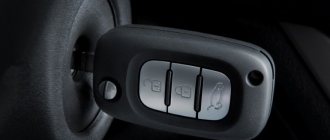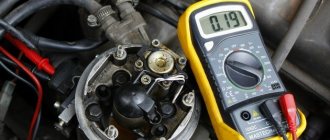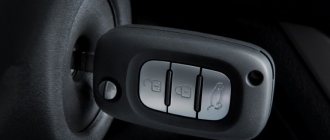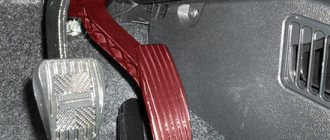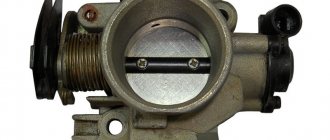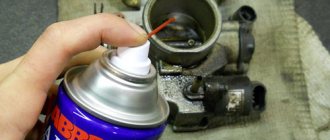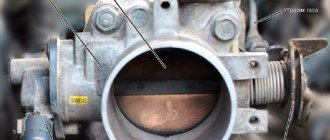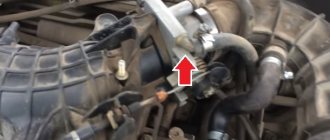Let's look at ways to adapt the throttle valve without special tools in garage conditions, tested on many car models - everyone is happy.
Good afternoon dear friends. We continue to deal with the throttle valve. Last time we learned how to independently check the throttle position sensor, today we will see how to independently adapt the throttle position sensor. Let's consider two methods, the first may not work on some cars, the second gives almost 100% results. Most car owners were able to solve throttle problems using these methods.
How to understand that the throttle needs “retraining”
The need for adaptation arises in the following cases:
- Unstable idle;
- High engine speeds at idle or very low on the verge of “about to stall”;
- When replacing the throttle or cleaning it;
- If an error is detected in the control unit;
- When replacing the ECU.
There were cases when, after a long period of inactivity or the onset of cold weather, the engine did not want to start or idle normally. That is, literally the first night of frost, and in the morning the car does not want to work normally. If you do not have special diagnostic equipment and software, you can carry out the adaptation yourself.
At a service station, this service will cost from 700 to 1000 rubles, depending on the make of the car.
Why should you pay money right away if you can try to “train” the throttle yourself?
Method number 1 – dancing with a tambourine, battery and ignition
Warm up the engine to operating temperature. Usually 80-90 degrees is enough and we turn off the engine.
Disconnect the battery and remove the terminal from it. This is necessary to reset the parameters in the control unit. In a simple way - reset the ECU to factory settings. This will allow the unit to retransmit the damper values in the closed position.
We wait five minutes. This is enough for the control unit to be completely de-energized. We connect the terminal to the battery. Don't forget to tighten it to make better contact.
Turn on the ignition and wait 30-40 seconds without touching or pressing anything. At this time, you may hear a buzzing noise under the hood. This adapts the throttle, the motor moves the damper, determining its position and recording this data in the ECU. This is typical only for electrical and electromechanical remote sensing devices.
Turn off the ignition and wait 15 seconds. After this time, we turn on the ignition, wait until all the indicators on the dashboard go out and start the car. We check the engine at idle speed, the speed should be normal.
It may not work on cars: Audi with a 1.8 liter ADR engine, Opel Corsa, Octavia Tour 1.6 akl engine, 4th generation Golf, Audi A4 ADL B5 body. All cars have non-volatile memory, which cannot be reset by removing the terminal from the battery.
If you were unable to teach using this method, write your car model in the comments.
Adjusting the engine damper sensor 1JZ
If, for example, you have a car with a 1JZ engine without VVTi, then it is regulated as follows:
We remove the throttle itself, remove the remote control sensor, adjust the damper with a stop screw so that when closing there remains a barely noticeable gap (it can be seen if you look at the light bulb through the remote control). We install the damper sensor and rotate it back and forth to such a position that when a 0.50 mm probe is placed under the thrust bolt, there is conductivity on the two lower contacts of the sensor, and if there is a 0.40 mm probe, then there is no circuit.
On a Toyota with a 3S-FE engine, the gap is 0.51 mm. The procedure for adjusting the TPS can be viewed here.
Method No. 2 – Dancing without a tambourine, but with a pedal and ignition
Throttle valve calibration can be divided into three stages:
- Training with the gas pedal released;
- With throttle fully closed;
- Air supply at idle.
First of all, warm up the car engine to operating temperature. We turn off the engine and wait 10 seconds.
Stage one
We make sure that the accelerator pedal is released and nothing is pressing on it. Turn on the ignition for 2 seconds and turn it off.
The throttle valve is a key element of the engine power system. It regulates the amount of air supplied to the cylinders, which, in turn, affects the idle speed and the number of revolutions. From time to time, the operating mode of this part changes, so it is necessary to adapt it. Moreover, you must first clean the damper, otherwise all efforts may be useless. Unfortunately, not every motorist knows how these procedures are carried out, although in fact they are not anything complicated.
We disassemble and clean the BDZ
After removing the throttle, you will need to prepare two bolts with a diameter of seven or eight millimeters, wrapped in rags. They will be required when disconnecting the coolant hoses from the BDZ. The bolts seal the hose outlets, which prevents antifreeze from spilling. The pipes are held on by clamps.
Subsequently, the 1NZ-FE throttle valve is disassembled and cleaned. To do this, you must complete the following steps:
- We dismantle the idle air valve 1NZ-FE by unscrewing three screws with a Phillips screwdriver. At this stage, difficulties may arise due to the oxidation of fasteners that stick tightly. As a result, the contact edge of the screw is licked off with a screwdriver. To unscrew them, you will need to drill out the screw heads. To do this, use a drill, a drill with a six-millimeter diameter. The thread remaining in the seat can be unscrewed without problems;
- Using a special liquid, we clean the 1NZ-FE throttle valve. It is necessary to thoroughly wash off black soot and oil deposits. In the future, it remains to reassemble the BDZ in the reverse order, using new screws to secure the idle air valve and gasket.
Removing the throttle
The throttle mechanism must be removed before cleaning and training. This is quite easy to do on a Toyota Corolla E120 and E150. Since 2002, the manufacturer began installing 1.6-liter power units on all cars in the series, so the dismantling process is the same for them.
The order for the Corolla Fielder is somewhat different, since the station wagon appeared in 2000 as a kind of offshoot from the main series. Nevertheless, the difference is insignificant, and it lies only in the principle of operation of the throttle, which is mechanical, so there is no need to look for an electronic sensor.
On later models, starting with the 2008 Corolla, the systems were unified and all powerplants now feature electronic throttle.
Under the hood, the engine is located openly, so finding the necessary elements is not difficult. Those drivers who are getting acquainted with the engine for the first time and do not know what this or that component looks like can see many photos on the Internet that show in detail all the external features of this or that part. The first step is to remove the air filter pipe, which is located on the left side of the power unit and on the right of the gas distribution mechanism. To disconnect the throttle itself, just unscrew the four bolts that secure the part to the timing belt. Now you can start cleaning the throttle body of the Toyota Corolla 150, which will be the same for the 120 models.
Similar products
However, if you touch them, they will break off, straighten out to their original position and begin to flow again. Therefore, we take the two previously unscrewed bolts and screw them into the tube. In this way, we will stop the leak and can continue to go about our business without thinking about them.
We do it as indicated in the photo. The photo shows the throttle from the reverse side. It is worth paying attention to the amount of dirt that is there.
Other articles
However, that's not all. Next, after removing the throttle from the power unit, we need to unscrew the XX sensor, which is mounted on three bolts. To do this, we take DW liquid, wet the bolts, a little later take a Phillips screwdriver and unscrew the three bolts.
The location of the bolts is shown by red arrows in the photo below. But before unscrewing the bolts, it is worth drawing several lines at the junctions of the two parts.
This approach will allow you to perfectly accurately return everything to its place when assembling the part. Remember, there must be at least three marks - one on each side. After unscrewing the bolts, carefully disconnect the parts from each other. As we can see, there is carbon deposits inside that need to be cleaned. Therefore, we take a cleaner, soft brushes, rags and try to clean all the corners of the disassembled part as much as possible. The photo below shows how much dirt is inside.
After cleaning everything should be shiny.
After cleaning the XX, it is necessary to clean the throttle itself, as well as its seat. In order to clean, we need to generously fill everything with purchased carburetor fluid. This is very easy to do, because a can with a tube allows you to do this in almost all inaccessible places.
We give the throttle valve a few minutes to soak and begin cleaning. This should be done as carefully as possible so as not to damage the inner surface or disrupt any mechanism. This is especially true for the inside of this unit.
Cleaning the throttle valve
First of all, to clean the part you need to buy washing liquid for the carburetor. It costs about 200–300 rubles per can, so you don’t need to worry about the cost of the issue. In addition, you will need a dry cloth that should not leave any lint. So how do you clean your throttle body? Everything is very simple.
You need to spray the purchased liquid onto the part and gently wipe it with a rag. It is worth repeating the procedure several times until the dirt and deposits are completely removed.
Many motorists ask the question: “We clean the intake manifold, but engine performance does not improve. What are we doing wrong? The fact is that this part does not need to be touched at all. Of course, extra flushing will not cause harm, but there is no need to waste time on it. The deposits formed in the collector are insignificant, so they do not interfere in any way.
How often should you clean your throttle body? It is impossible to answer this question with an exact number, since it is recommended to carry out this procedure every time the engine oil is changed. Some people do this twice a year, and others once every two years. After how long the lubricant is changed, the same time it needs to be changed.
Throttle valve adaptation
After the driver has successfully cleaned the part, you need to reassemble the entire mechanism in the reverse order, and then proceed to the main procedure.
Training should only take place if a number of preconditions are met. First, the power unit needs to be warmed up to operating temperature. Then you should turn off all electronics (headlights, DRLs, audio system, etc.). The car must be on a flat surface, since adaptation will require moving the gear lever to neutral.
After the car has been prepared, training should begin. First, you need to disconnect the battery terminal for 5 minutes. After waiting 5 minutes, you need to return it to its place. Next, the ignition is turned, but the engine itself does not need to be started. After all the indicators on the dashboard light up, you need to wait 30 seconds.
Leaving the ignition in place, you should again disconnect the terminal from the battery for the same time, then return it to its place, start the engine and wait 15 minutes.
As a result, the idle speed will be adjusted and the air supply will be normalized.
Fuel system or dirty intake?
When mentioning a dirty intake, many drivers immediately begin to suspect the fuel injectors for all the troubles. It must be said that such a fear exists, but, alas, it is not always confirmed. Let's first look at the symptoms associated with a faulty fuel system and a dirty intake. So, if the fuel system in a car is faulty, the following problems may occur:
- difficult starting;
- “triple” of the engine, both at idle and while driving;
- significant reduction in traction;
- slow speed increase;
- the car may stall frequently;
- The “Check Engine” icon appears on the dashboard.
Not a small set of problems, is it? With a faulty fuel system, all of these problems can occur individually or all together. However, such malfunctions are typical not only in the case of a faulty fuel system, but in 70% of cases, if several of the symptoms listed above are present, the problem lies in a faulty fuel pump or fuel injectors. This problem is difficult to solve on your own, because this will require the help of a qualified specialist and diagnostics of the electronic control unit (ECU) using a special scanner.
The problem with a dirty inlet is much easier to solve; for this you do not need to disassemble the fuel rail, etc., it will be enough to unscrew a few screws, disconnect the electrical wiring and remove several pipes. It is also worth noting that the problem of “dirty intake” is not displayed on the dashboard by the “Check Engine” indicator, but this only happens if the sensors (TPS and MAF) are working properly.
Let's look at the symptoms associated with a dirty intake:
- high idle speeds at the time of start-up, which do not fall below a certain level (usually the speeds do not fall below 1200-1500, less often - 900-1100);
- increased fuel consumption (can reach from 0.5 to 1.0 liters, depending on the condition of the engine);
- poor response to the gas pedal “the car stalls, does not drive at full power.”
Remember that if similar symptoms appear on your car, but the “Check Engine” warning light does not light up on the dashboard, and scanners do not detect errors during diagnostics, in 95% of cases the problem lies in a dirty throttle valve.
Signs of trouble
The operation of the Toyota Corolla idle speed sensor is designed by the manufacturer for the entire service life of the engine, but sometimes problems with the wiring, as well as the appearance of soot, oxidation and other deposits on the walls of the sensor lead to its failure.
A malfunction of the device can be indicated by such changes in the operation of the car as:
- increase in the amount of fuel consumed;
- instability of speed when there is no load on the engine;
- increased level of engine vibration;
- The car starts to stall at low speeds.
All these factors are a reason to diagnose the idle air regulator, identify the cause of the malfunction and clean or replace the part.
Problems with the sensor lead to rapid wear of the power unit and the entire fuel system of the car, so they must be corrected as soon as possible.
Video: How to train a TOYOTA throttle, cleaning the throttle errors.
Intake malfunctions, what to do and what to do?
Typically, malfunctions associated with the throttle valve on the Toyota Corolla 150 occur at high mileage (over 100,000 - 120,000 km). However, there are cases when malfunctions of the throttle assembly occur at short distances (around 60,000 km), in which case the causes of these malfunctions may be:
- a defective part in the throttle assembly (TPS - throttle position sensor) - practically never occurs;
- the so-called “throwing” of the throttle assembly (from the cylinder head side) with exhaust gas products due to the crankcase ventilation system is a common problem;
- the use of a low-quality air filter or its contamination (due to non-compliance with maintenance) is rare.
If problems arise related to a malfunction of the throttle assembly, do not panic ahead of time, because these problems can be easily solved with your own hands; you just need a little time and tools. However, before starting to disassemble the throttle assembly, we first of all strongly recommend diagnosing the electronic control systems (either at a service center or independently using a scanner).
And we warn all those who dare to repair the throttle assembly with their own hands that our editors are not responsible for your actions! You perform all work at your own peril and risk!
The ways to solve problems are as follows:
- with all sensors in working order (TPS and MAF), the throttle assembly is removed from the car, then washed, after which it is installed back and adaptation/learning of the throttle valve is performed;
- if the TPS sensor is faulty, the throttle assembly should be replaced with a new one (since the TPS sensor is installed directly in the throttle body body);
- If the MAF sensor is faulty, it should be washed or replaced with a new one.
The functionality of the sensors can be checked using a scanner; if there are no errors, it can be additionally checked using a multimeter/oscilloscope. More detailed information about sensor indicators can be found in the vehicle manual.
- throttle assembly assembly (with TPS): used - from 3000 rubles, new - from 6500 rubles;
- Mass air flow sensor (MAF): used - from 1500 rubles, new - from 4500 rubles.
Instructions and clearances of the remote sensing sensor
For example, if you need to adjust the TPS clearances for a 2JZ-GTE engine, then you need to have feeler gauges from 0.50 to 0.75 and a multimeter.
Start re-cocking the damper and at the moment of movement when you feel that the damper is “biting”. You begin to tighten the upper stop screw until the blow is still loud, but there is no biting. Then, taking the hexagon, insert it into the stop screw and use the lock nut to lock the screw. In this case, the hexagon will not allow the screw to go out even further. With this adjustment, THERE WILL BE NO GAP! Then carefully adjust the second lower screw to the first.
Now how it is regulated in practice, it looks like this:
We put contacts on the TPS, connect the multimeter and slightly lower the TPS screws. Having turned the sensor all the way (counterclockwise), we look at what the multimeter shows us - either 0.00 (closed) or 1 (contact broken).
Then insert a 0.65 mm feeler gauge between the first stop bolt and the throttle valve. Gently tapping with the end of a screwdriver, we move the TPS clockwise until the moment comes when the multimeter shows “1” from 0.00, after which we immediately stop.
Carefully tighten the screws securing the throttle sensor to the throttle body. At the same time, we look at the woman’s tester and nothing has moved.
Now a check is carried out: when installing a 0.50 mm probe, it should be 0.00, and when installing a 0.70 mm probe, it should be 1.
